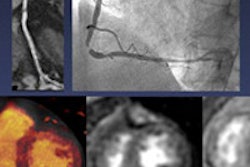Dear AuntMinnie Member,
The storyline for the breast density notification movement has been an inspirational one so far, as a growing number of state legislatures pass laws requiring women to be told if they have dense breast tissue. But the movement may have suffered a setback this week with the publication of a new study pointing out the high cost -- and questionable return -- of following up these women with supplemental ultrasound.
Researchers from the University of Vermont and several other institutions performed an analysis using statistical models to assess how much it would cost to use breast ultrasound to follow up women who have dense breast tissue. Ultrasound is typically used in these situations due to the difficulty that x-ray-based mammography has in penetrating dense tissue.
The group found that ultrasound would add millions to the cost of breast screening, while not meeting standard thresholds for the cost-effectiveness of a screening test based on the cost per quality-adjusted life years -- basically, the number of life years that would be saved by the intervention.
Advocates from the breast density notification movement have been quick to fire back, pointing out that the study shouldn't affect what they believe is a fundamental patient right: to know about breast tissue density status.
Read more by clicking here, or visit our Women's Imaging Community at women.auntminnie.com.
Personal CT radiation shields reduce dose
Imaging facilities are investigating a variety of tools for reducing radiation dose to patients. One of the simplest -- a personal radiation shield that patients would wear during a scan -- was the subject of an intriguing presentation at last week's RSNA 2014 meeting.
Researchers from Las Vegas investigated the usefulness of a reusable, lead-free shielding pad that covered parts of the body that weren't the subject of the CT exam, tracking CT dose over a five-year period in which the shields were used.
They called the results "dramatic," with radiation dose falling by as much as 77% for extremity scans, and in the 40% to 50% range for most other procedures.
Learn more about the study by clicking here, or visit our CT Community at ct.auntminnie.com.




















